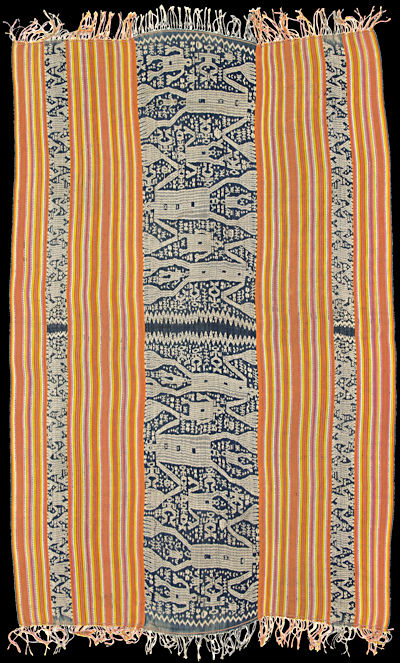| |
 
 | | | |
349 Timor, West Timor
Mau (men's wrap)
| | Locale: | Amanatun, most likely Amanatun Utara | | Period: | Mid 20th c. | | Yarn: | Cotton, machine made, used double ply in the ikated areas, quadruple ply in the red and yellow couloured bands. | | Technique: | Warp ikat | | Panels: | 3 | | Size: | 115 x 180 cm (3' 9" x 5' 10") LW: 1.57 | | Design: | The midfield is dominated by large and small human figures with upraised hands, commonly assumed to represent ancestors. The four here shown upright are taken to be male, the two in reversed position, with different, more elaborate rendering of the genitals, are taken to female. Smaller human figures, with and without genitals, as well as human figures drawn to look like frogs, katak, are used as fillers. The katak motifs are often shown nested, representing the continuity of generations. The narrower ikated bands carry squat human figures. In between the main motifs the dyers placed myriad small fillers. The ikat work is all done in natural indigo, the red and yellow bands in between are coloured with synthetic dyes. | | Comment: | The field division, with a wide ikated midfield and two narrower ikated bands close to the selvedges is characteristic for Amanatun - and can help differentiate between wraps made in Amanatun and those from Amanuban, where similar patterns are ikated, but which typically do not have the narrower ikated bands along the selvedges. Another difference is that wraps made in Amanuban often have red elements in their designs, whereas those from Amanatun tend to be ikated in indigo only. | | Background: | Chapters on Timor and West Timor. | | Sources: | Yeager & Jacobson show similar arrangements of human figures encountered on wraps from Amanatun (2002: Fig. 46 c, h, i). The authors also depict a variety of katak motifs from both Amanatun and Amanuban (ibid: Fig. 45). | | |

©Peter ten Hoopen, 2025
All rights reserved.
|
|


